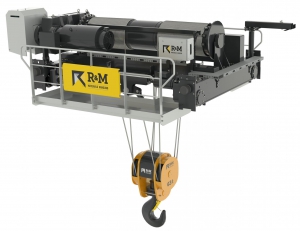
The PDW is tailored to meet your specific process-duty requirements. The modular design of the hoist and trolley allows for a wide variety of application-specific designs. Choose from an abundance of special features, such as specialty hooks and provisions for below the hook devices, precision load and sway controls or a maintenance platform. The PDW gives you big impact, in a compact package.
Standard Features
- 6 – 70 ton (6,000 - 70,000 kg) capacities
- Wide range of available lifts and lifting speeds
- Main power supply for 460V-3PH-60Hz or 380-3PH-50Hz
- ASME H4 or H5 duty class (ISO M6-M7) for hoisting
- CMAA Class C-E trolleys (ISO M5-M7) for heavy-duty operation
- Ambient temperatures 41°F - 113°F [5°C - 45°C]
- Inverter duty motors for all motions providing smooth operation and reduced load sway
- Hook latch trigger included
- Extended Speed Range (ESR) with load floating for hoisting
- Shock Load Prevention
- CSA C/US rated
Why Choose the PDW?
Heavy-duty lifting requires heavy-duty solutions. The PDW helps you to rise above the most demanding material handling applications.
Rugged
Our purpose-built components are designed and manufactured in-house, specifically for hoisting, trolley and crane motions, meaning you get the optimal balance of power, performance and cost in the industry. Optional additional features, such as a thruster-type disc brake, helps the PDW to stand up to demanding process-duty applications.
Safe
Our standard overload limiter with built-in condition monitoring assists in the safe operation of your equipment and allows for predictive maintenance monitoring. The two-point, flange mounted drum suspension allows the gearbox and hoist motor to articulate when the rope drum is bent under load, meaning no misalignment in the connection between the rope drum drive end and gearbox and extended gearbox bearing life.
Smart
The PDW features our inverter-controlled hoisting with an Extended Speed Range (ESR), meaning you get precision controls coupled with extended speeds when there is no load or a low load on the hook. ESR allows the operator to gain two times the rated speed of the hoist when the load lifted is 20% or less of the rated capacity. Because we design our motors and inverters together as a part of our Core of Lifting strategy, we are also able to reduce the size and cost of the drive train by optimizing the complete system.
